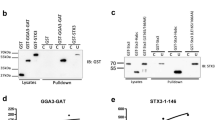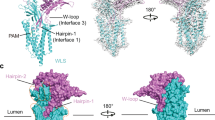Abstract
The GXGD proteases are polytopic membrane proteins with catalytic activities against membrane-spanning substrates that require a pair of aspartyl residues1,2,3,4. Representative members of the family include preflagellin peptidase, type 4 prepilin peptidase, presenilin and signal peptide peptidase. Many GXGD proteases are important in medicine. For example, type 4 prepilin peptidase may contribute to bacterial pathogenesis5,6,7, and mutations in presenilin are associated with Alzheimer’s disease8,9,10. As yet, there is no atomic-resolution structure in this protease family. Here we report the crystal structure of FlaK, a preflagellin peptidase from Methanococcus maripaludis, solved at 3.6 Å resolution. The structure contains six transmembrane helices. The GXGD motif and a short transmembrane helix, helix 4, are positioned at the centre, surrounded by other transmembrane helices. The crystal structure indicates that the protease must undergo conformational changes to bring the GXGD motif and a second essential aspartyl residue from transmembrane helix 1 into close proximity for catalysis. A comparison of the crystal structure with models of presenilin derived from biochemical analysis reveals three common transmembrane segments that are similarly arranged around the active site. This observation reinforces the idea that the prokaryotic and human proteases are evolutionarily related11,12. The crystal structure presented here provides a framework for understanding the mechanism of the GXGD proteases, and may facilitate the rational design of inhibitors that target specific members of the family.
This is a preview of subscription content, access via your institution
Access options
Subscribe to this journal
Receive 51 print issues and online access
$199.00 per year
only $3.90 per issue
Buy this article
- Purchase on Springer Link
- Instant access to full article PDF
Prices may be subject to local taxes which are calculated during checkout




Similar content being viewed by others
References
Wolfe, M. S. et al. Two transmembrane aspartates in presenilin-1 required for presenilin endoproteolysis and γ-secretase activity. Nature 398, 513–517 (1999)
LaPointe, C. F. & Taylor, R. K. The type 4 prepilin peptidases comprise a novel family of aspartic acid proteases. J. Biol. Chem. 275, 1502–1510 (2000)
Weihofen, A., Binns, K., Lemberg, M. K., Ashman, K. & Martoglio, B. Identification of signal peptide peptidase, a presenilin-type aspartic protease. Science 296, 2215–2218 (2002)
Bardy, S. L. & Jarrell, K. F. Cleavage of preflagellins by an aspartic acid signal peptidase is essential for flagellation in the archaeon Methanococcus voltae . Mol. Microbiol. 50, 1339–1347 (2003)
Lory, S. & Strom, M. S. Structure-function relationship of type-IV prepilin peptidase of Pseudomonas aeruginosa—a review. Gene 192, 117–121 (1997)
Craig, L., Pique, M. E. & Tainer, J. A. Type IV pilus structure and bacterial pathogenicity. Nature Rev. Microbiol. 2, 363–378 (2004)
Sandkvist, M. Type II secretion and pathogenesis. Infect. Immun. 69, 3523–3535 (2001)
Selkoe, D. J. & Wolfe, M. S. Presenilin: running with scissors in the membrane. Cell 131, 215–221 (2007)
Jorissen, E. & De Strooper, B. γ-secretase and the intramembrane proteolysis of Notch. Curr. Top. Dev. Biol. 92, 201–230 (2010)
Brouwers, N., Sleegers, K. & Van Broeckhoven, C. Molecular genetics of Alzheimer’s disease: an update. Ann. Med. 40, 562–583 (2008)
Steiner, H. et al. Glycine 384 is required for presenilin-1 function and is conserved in bacterial polytopic aspartyl proteases. Nature Cell Biol. 2, 848–851 (2000)
Rawlings, N. D., Morton, F. R., Kok, C. Y., Kong, J. & Barrett, A. J. MEROPS: the peptidase database. Nucleic Acids Res. 36, D320–D325 (2008)
Francetic, O., Buddelmeijer, N., Lewenza, S., Kumamoto, C. A. & Pugsley, A. P. Signal recognition particle-dependent inner membrane targeting of the PulG Pseudopilin component of a type II secretion system. J. Bacteriol. 189, 1783–1793 (2007)
Bayley, D. P. & Jarrell, K. F. Overexpression of Methanococcus voltae flagellin subunits in Escherichia coli and Pseudomonas aeruginosa: a source of archaeal preflagellin. J. Bacteriol. 181, 4146–4153 (1999)
Kalmokoff, M. L., Karnauchow, T. M. & Jarrell, K. F. Conserved N-terminal sequences in the flagellins of archaebacteria. Biochem. Biophys. Res. Commun. 167, 154–160 (1990)
Bardy, S. L. & Jarrell, K. F. FlaK of the archaeon Methanococcus maripaludis possesses preflagellin peptidase activity. FEMS Microbiol. Lett. 208, 53–59 (2002)
Killian, J. A. & von Heijne, G. How proteins adapt to a membrane–water interface. Trends Biochem. Sci. 25, 429–434 (2000)
Wang, Y., Maegawa, S., Akiyama, Y. & Ha, Y. The role of L1 loop in the mechanism of rhomboid intramembrane protease GlpG. J. Mol. Biol. 374, 1104–1113 (2007)
Bondar, A. N., del Val, C. & White, S. H. Rhomboid protease dynamics and lipid interactions. Structure 17, 395–405 (2009)
Ha, Y. Structure and mechanism of intramembrane protease. Semin. Cell Dev. Biol. 20, 240–250 (2009)
Tolia, A., Chavez-Gutierrez, L. & De Strooper, B. Contribution of presenilin transmembrane domains 6 and 7 to a water-containing cavity in the γ-secretase complex. J. Biol. Chem. 281, 27633–27642 (2006)
Tolia, A., Horre, K. & De Strooper, B. Transmembrane domain 9 of presenilin determines the dynamic conformation of the catalytic site of γ-secretase. J. Biol. Chem. 283, 19793–19803 (2008)
Laudon, H. et al. A nine-transmembrane domain topology for presenilin 1. J. Biol. Chem. 280, 35352–35360 (2005)
Spasic, D. et al. Presenilin-1 maintains a nine-transmembrane topology throughout the secretory pathway. J. Biol. Chem. 281, 26569–26577 (2006)
Narayanan, S., Sato, T. & Wolfe, M. S. A C-terminal region of signal peptide peptidase defines a functional domain for intramembrane aspartic protease catalysis. J. Biol. Chem. 282, 20172–20179 (2007)
Sato, C., Morohashi, Y., Tomita, T. & Iwatsubo, T. Structure of the catalytic pore of γ-secretase probed by the accessibility of substituted cysteines. J. Neurosci. 26, 12081–12088 (2006)
Sato, C., Takagi, S., Tomita, T. & Iwatsubo, T. The C-terminal PAL motif and transmembrane domain 9 of presenilin 1 are involved in the formation of the catalytic pore of the γ-secretase. J. Neurosci. 28, 6264–6271 (2008)
Ponting, C. P. et al. Identification of a novel family of presenilin homologues. Hum. Mol. Genet. 11, 1037–1044 (2002)
Davies, D. R. The structure and function of the aspartic proteinases. Annu. Rev. Biophys. Biophys. Chem. 19, 189–215 (1990)
Wang, Y. & Ha, Y. Open-cap conformation of intramembrane protease GlpG. Proc. Natl Acad. Sci. USA 104, 2098–2102 (2007)
Kaback, H. R. & Stadtman, E. R. Proline uptake by an isolated cytoplasmic membrane preparation of Escherichia coli . Proc. Natl Acad. Sci. USA 55, 920–927 (1966)
Otwinowski, Z. & Minor, W. Processing of X-ray diffraction data collected in oscillation mode. Methods Enzymol. 276, 307–326 (1997)
Wang, B. C. Resolution of phase ambiguity in macromolecular crystallography. Methods Enzymol. 115, 90–112 (1985)
Pape, T. & Schneider, T. R. HKL2MAP: a graphical user interface for macromolecular phasing with SHELX programs. J. Appl. Cryst. 37, 843–844 (2004)
Collaborative Computational Project, 4. The CCP4 suite: programs for protein crystallography. Acta Crystallogr. D 50, 760–763 (1994)
Jones, T. A., Zou, J. Y., Cowan, S. W. & Kjeldgaard, M. Improved methods for building protein models in electron density maps and the location of errors in these models. Acta Crystallogr. A 47, 110–119 (1991)
Brünger, A. T. et al. Crystallography & NMR system: A new software suite for macromolecular structure determination. Acta Crystallogr. D 54, 905–921 (1998)
Winn, M. D., Murshudov, G. N. & Papiz, M. Z. Macromolecular TLS refinement in REFMAC at moderate resolutions. Methods Enzymol. 374, 300–321 (2003)
Nicholls, A., Sharp, K. A. & Honig, B. Protein folding and association: insights from the interfacial and thermodynamic properties of hydrocarbons. Proteins 11, 281–296 (1991)
Loo, T. W. & Clarke, D. M. Determining the dimensions of the drug-binding domain of human P-glycoprotein using thiol cross-linking compounds as molecular rulers. J. Biol. Chem. 276, 36877–36880 (2001)
Green, N. S., Reisler, E. & Houk, K. N. Quantitative evaluation of the lengths of homobifunctional protein cross-linking reagents used as molecular rulers. Protein Sci. 10, 1293–1304 (2001)
Acknowledgements
We thank A. Héroux, H. Robinson and A. Soares at NSLS, and J. Schuermann at APS NE-CAT for their help during data collection. X-ray diffraction data were measured at beamlines X25 and X29 at NSLS, and at 24-ID-C and 24-ID-E at APS. Financial support was principally from the US Department of Energy and from the National Institutes of Health. This work was supported by a New Scholar Award in Aging from the Ellison Medical Foundation (to Y.H.), a gift from the Neuroscience Education and Research Foundation (to Y.H.) and a pilot grant from Yale’s programme in Cellular Neuroscience, Neurodegeneration, and Repair (CNNR) (to Y.H.).
Author information
Authors and Affiliations
Contributions
J.H. and Y.X. purified and characterized FlaK in various detergents. J.H. obtained the high-resolution crystals of FlaK. J.H., Y.X. and Y.H. solved the crystal structure. Y.H., Y.X. and J.H. wrote the paper. Y.X. and S.L. screened many constructs and performed the initial biochemical and functional characterizations.
Corresponding author
Ethics declarations
Competing interests
The authors declare no competing financial interests.
Supplementary information
Supplementary Information
The file contains Supplementary Figures 1-6 with legends, Supplementary Table 1 and additional references. (PDF 1360 kb)
Rights and permissions
About this article
Cite this article
Hu, J., Xue, Y., Lee, S. et al. The crystal structure of GXGD membrane protease FlaK. Nature 475, 528–531 (2011). https://doi.org/10.1038/nature10218
Received:
Accepted:
Published:
Issue Date:
DOI: https://doi.org/10.1038/nature10218
This article is cited by
-
Physiological functions of SPP/SPPL intramembrane proteases
Cellular and Molecular Life Sciences (2020)
-
Effect of changes at the conserved + 3 position of mature archaellins on in vitro cleavage by the pre-archaellin peptidase FlaK of Methanococcus maripaludis
Archives of Microbiology (2020)
-
Binding of longer Aβ to transmembrane domain 1 of presenilin 1 impacts on Aβ42 generation
Molecular Neurodegeneration (2014)
-
Dissection of key determinants of cleavage activity in signal peptidase III (SPaseIII) PibD
Extremophiles (2014)
-
Mechanism of farnesylated CAAX protein processing by the intramembrane protease Rce1
Nature (2013)
Comments
By submitting a comment you agree to abide by our Terms and Community Guidelines. If you find something abusive or that does not comply with our terms or guidelines please flag it as inappropriate.



